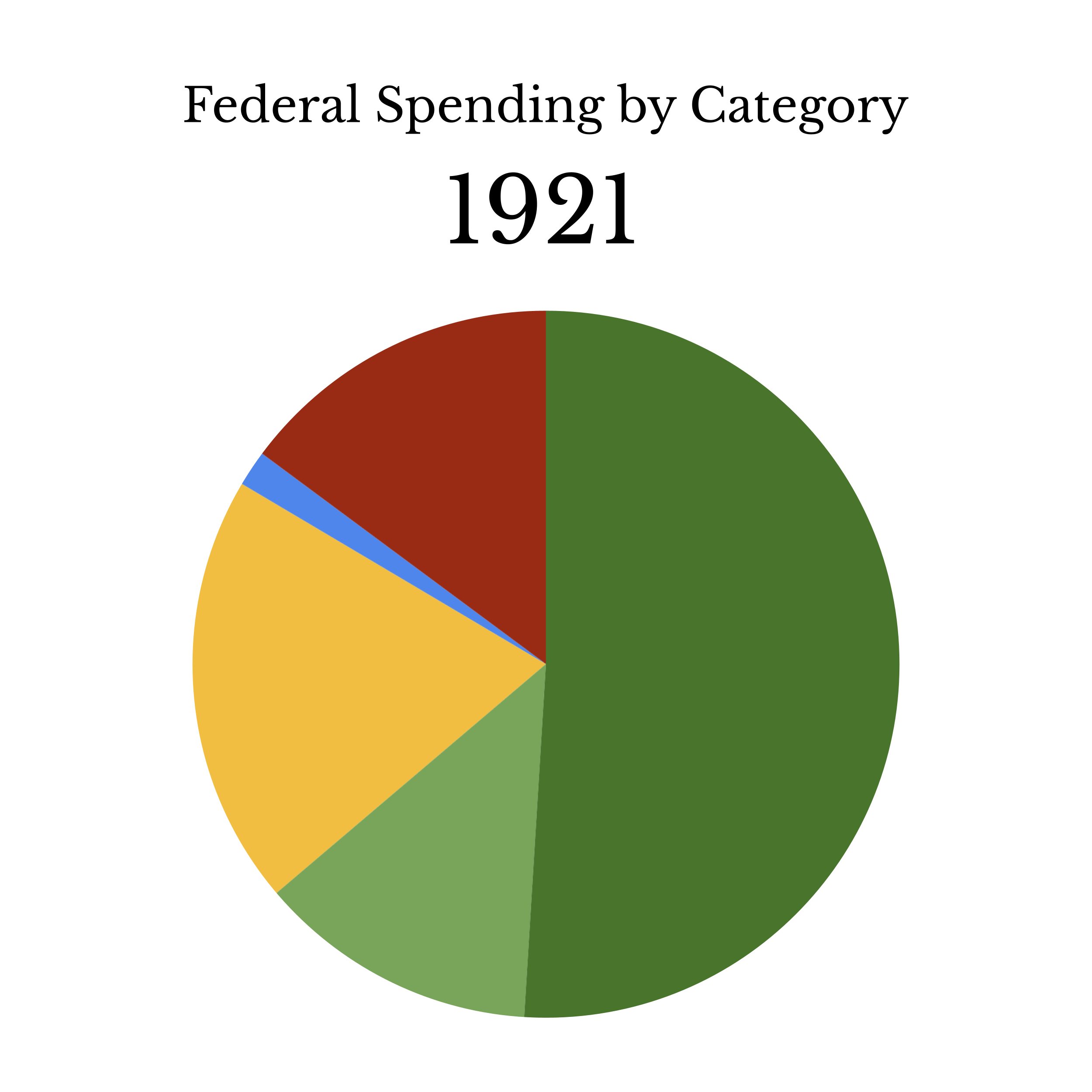
BUDGETS
Categories
Note: All estimates are approximate.
Commentary
Expenditures for World War I reached an apex in 1919; costs wound down gradually into the early 1920s. Between 1921 and 1929, several trends emerged. As a share of total spending, military spending dropped by about half. Yet in an era without antibiotics or advanced prosthetics, many of the millions of veterans who returned home demanded, and often needed, support. In the 1920s, Congress responded by upping spending on veterans’ support—over Coolidge’s protests and veto. In the 1920s, interest payments stood steady at 20 to 30 percent of total spending. It is useful to note that early on, in 1921, interest payments on the debt accounted for more spending than did either veterans or non-military spending.
Today our budget looks different. The category of domestic spending includes entitlements created in the New Deal of the 1930s and the Great Society of the 1960s and 1970s (Medicare and Medicaid, for example) along with other benefits. These days our budget terminology often confuses the public. Entitlements are classed as “mandatory” outlays whereas military spending is classed as “discretionary.” Dropping these modern divisions helps us to see the extent to which entitlements dominate our budget. Relative to all federal spending, military spending these days is smaller than in the past.
To view budget pie charts for fiscal years 1915 through 1932, as well as 2019, click here.
Sources
Kendrick, M. Slade, and Mark Wehle. A Century and a Half of Federal Expenditures. New York, NY: National Bureau of Economic Research, 1955. https://www.nber.org/books-and-chapters/century-and-half-federal-expenditures
The 1921 and 1929 charts are based on data from Table B1-Panel A in Appendix B to A Century and a Half of Federal Expenditures by M. Slade Kendrick and Mark Wehle (1955). The authors used (and adjusted some) data from the Annual Report of the Secretary of the Treasury for 1950 and other years and then organized these data into five categories — “Military,” “Veterans,” “Interest,” “Foreign,” and “Civil.” Authors derived these five categories from the seven categories used in the 1940 Annual Report (see Table 6, pp. 646-49). “Military” and “Interest” remain unchanged. “Veterans” was relabeled “Veteran Support” to more ably reflect the components it contained in the 1920s and present day. “Foreign” includes both military and nonmilitary aid to foreign countries and has been relabeled “International.” The authors kept foreign military aid separate from ordinary military expenditures because all of it was allocated to governments other than the U.S. government. “Civil” has been relabeled “Domestic Spending and Other” to accommodate the greater breadth of outlays present in this category today. The authors calculated “Civil” by subtracting “Military,” “Veterans,” “Interest,” and “Foreign” from total expenditures.
U.S. Office of Management and Budget. “Historical Tables” in Budget of the U.S. Government for Fiscal Year 2023. OMB. 2022. https://www.whitehouse.gov/omb/budget/historical-tables/.
The 2019 chart is based on data from Table 3.1 in the Historical Tables section of the President’s Budget for Fiscal Year 2023 published by the Office of Management and Budget. Table 3.1 presents outlays sorted by ‘function,’ i.e., the primary purpose of the outlay, and then ‘superfunction,’ i.e., a more top-line summary of outlays. The “Defense” superfunction was relabeled “Military.” The “Veterans Benefits and Services” function was subtracted from the “Human resources” superfunction and then relabeled “Veteran Support.” The “Net interest” superfunction was relabeled “Interest.” The “International Affairs” function was subtracted from the “Other functions” superfunction and relabeled “International.” The category we label “Domestic Spending and Other” was calculated by subtracting “Defense,” “Net interest,” “Veterans Benefits and Services,” and “International affairs” from the total outlays.
View the Original Budgets
Note: President Harding signed the budgets for fiscal years 1923 and 1924 (from July 1, 1922 to June 30, 1924). President Coolidge signed the budgets for fiscal years 1925 through 1930 (from July 1, 1924 to June 30, 1930).
Budget for the Fiscal Year Ending June 30, 1923
Citation: United States. Bureau of the Budget and United States. Office of Management and Budget. "Fiscal Year Ending June 30, 1923," Budget of the United States Government (December 5, 1921). https://fraser.stlouisfed.org/title/54#18966.
Budget for the Fiscal Year Ending June 30, 1924
Citation: United States. Bureau of the Budget and United States. Office of Management and Budget. "Fiscal Year Ending June 30, 1924," Budget of the United States Government (December 4, 1922). https://fraser.stlouisfed.org/title/54#18967.
Budget for the Fiscal Year Ending June 30, 1925
Citation: United States. Bureau of the Budget and United States. Office of Management and Budget. "Fiscal Year Ending June 30, 1925," Budget of the United States Government (December 3, 1923). https://fraser.stlouisfed.org/title/54#18968.
Budget for the Fiscal Year Ending June 30, 1926
Citation: United States. Bureau of the Budget and United States. Office of Management and Budget. "Fiscal Year Ending June 30, 1926," Budget of the United States Government (December 1, 1924). https://fraser.stlouisfed.org/title/54#18969.
Budget for the Fiscal Year Ending June 30, 1927
Citation: United States. Bureau of the Budget and United States. Office of Management and Budget. "Fiscal Year Ending June 30, 1927," Budget of the United States Government (January 7, 1925). https://fraser.stlouisfed.org/title/54#18970.
Budget for the Fiscal Year Ending June 30, 1928
Citation: United States. Bureau of the Budget and United States. Office of Management and Budget. "Fiscal Year Ending June 30, 1928," Budget of the United States Government (December 6, 1926). https://fraser.stlouisfed.org/title/54#18971.
Budget for the Fiscal Year Ending June 30, 1929
Citation: United States. Bureau of the Budget and United States. Office of Management and Budget. "Fiscal Year Ending June 30, 1929," Budget of the United States Government (December 5, 1927). https://fraser.stlouisfed.org/title/54#18972.
Budget for the Fiscal Year Ending June 30, 1930
Citation: United States. Bureau of the Budget and United States. Office of Management and Budget. "Fiscal Year Ending June 30, 1930," Budget of the United States Government (December 3, 1928). https://fraser.stlouisfed.org/title/54#18973.




